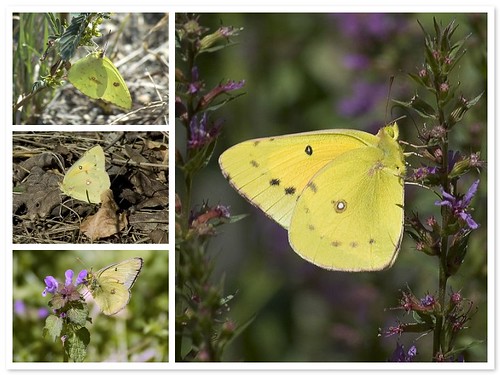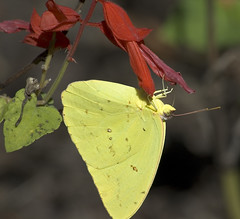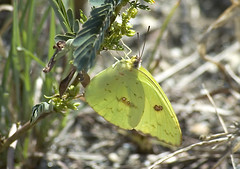ID Quiz 1.2: Sulphurs
Some of the most common butterflies in this area are the sulphurs, part of the family Pieridae, which includes most white and yellow butterflies. In the tri-state area, most of the sulphurs (sub-family Coliadinae) are members of four genuses: Colias (Orange Sulphur, Clouded Sulphur, Pink-Edged Sulphur); Phoebis (Cloudless Sulphur); Pyrisitia (Little Yellow) and Abaeis (Sleepy Orange).
Occam’s Razor
The members of Colias and Phoebis are the most-often encountered, and the most often confused. The Little Yellow (Pyrisitia lisa) is a rare visitor, and when it does occur is more likely to be found in coastal locations in southern NJ. Plus, its size makes it easier to differentiate from the other species. Similarly, the Sleepy Orange (Abaeis nicippe) is also a rare visitor, and can be quickly identified by its lack of any eye spots on the wings.
Now on to the tougher ones
Of the remaining species, the most obvious one to ID is the Cloudless Sulphur (Phoebis sennae), so named because of the minimum of markings on the dorsal side of the wings, and – in the case of the female at least – larger eye spots than the other sulphurs. They are also distinguishable by its much larger size compared to the other sulphurs. See below for pictures of a male (left) and female (right). Note the drastic difference in eye spot size between the genders and compared to other sulphurs.
The two most common species are the Orange Sulphur (Colias eurytheme) and Clouded Sulphur (Colias philodice). These two butterflies are very similar, with the orange sulphurs being slight larger. One of the best ways to tell the two apart is the black border on the dorsal side of the wings is much more apparent on the orange sulphurs, added to the fact that clouded sulphurs can show little or no black border on the hind wing. However, this is all of little help since both species usually rest with their wings closed, which makes seeing the dorsal side difficult.
Thus, much of the identification of these two is made via the ventral surface of the wings. In the right light, the borders from the dorsal side can be seen through the wing, giving a quick field mark. In the absence of this, there are two key field marks that I use to differentiate between them: the spotting on the wing and the distinctive color of the forewing of the orange sulphur. While the overall color of orange sulphurs is – predictably – more orange, there is a highly visible patch of orange on the ventral side of the forewing which is apparent when the butterfly is at rest (top image). Clouded sulphurs show more yellow if any color (bottom image), and have lighter if any spotting along the rear margin of the wing.
The last species in this group is the Pink-Edged Sulphur (Colias interior). This species is very similar to both of the above species, with one major distinguishing characteristic – their namesake pink edge. When one sees this edge, it’s name becomes readily apparent; however, be careful not to misjudge an orange sulphur, which can also have a slight pink edge to it on many occasions – the pink-edged sulphur’s ‘edging’ will be noticebly larger. Two other field marks to be found on the ventral surface are the relative absence of any spots along the post-median line of the wings and a single spot on the hindwing (vs. the twin spots of both of the above species). Unfortunately, I don’t have any pictures of the pink-edged sulphur to show, but you can find several of them on Bugguide.net, a great resource for all things insect-related.
One More Wrinkle
Another species which is similar to the sulphurs is the ubiquitous Cabbage White (Pieris rapae), one of the most common butterflies in NJ. Both the orange sulphur and clouded sulphur have females which have a ‘white form’ which is lacking in yellow pigmentation, resulting in a very similar appearance to the cabbage white. However, the cabbage white is easy to differentiate – the dorsal black bands are absent save for a solid patch on the tips of the forewings, and they have one (male) or two (female) solid black spots on the forewing as well. Ventrally, those spots are also apparent, appearing in place of any eye spots. A picture of a male is on the left, and a shot of several females puddling is on the right.
For More Information
I forgot to mention this before, but there are a lot of great resources out there to help identify butterflies in this area (NJ-DE-PA tri-state area). I have listed them below, along with some links to more of my shots on Flickr.
• Butterflies through Binoculars – The East by Dr. Jeffrey Glassberg. An indispensable guide to butterflies in the eastern U.S.
• Butterflies and Moths of North America Maps. The official butterfly site, as it were, with state checklists of butterflies.
• Bugguide.net. A great site for information on all types of insects (and related bugs, such as spiders) in North America.
• Pictures of Sulphurs on Flickr
• ID/Compare Set on Flickr
• Colias IDing – Thanks, Anita!







Nice article and photographs.